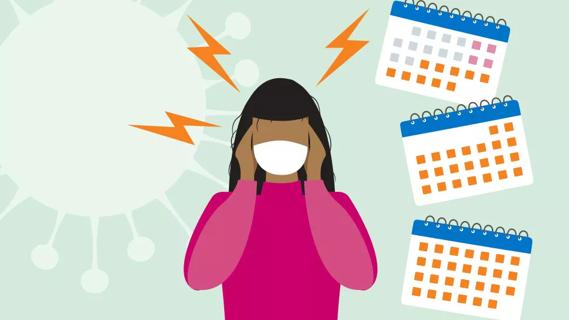Your survival response explained

Someone cut you off on the highway and you had to swerve and narrowly avoided a collision.
Cleveland Clinic is a non-profit academic medical center. Advertising on our site helps support our mission. We do not endorse non-Cleveland Clinic products or services. Policy
While out for a morning run, an angry dog jumps out onto your path and starts growling and barking at you.
In the second before you turned on the lights in your empty house, your coat rack looked like it was a person standing right next to you.
All three of these scenarios can trigger your body’s natural fight-or-flight response, which is driven by your sympathetic nervous system. This response is your body’s reaction to danger and was designed to help you survive stressful and life-threatening situations.
“The fight-or-flight response, or stress response, is triggered by a release of hormones either prompting us to stay and fight or run away and flee,” explains psychologist Carolyn Fisher, PhD. “During the response, all bodily systems are working to keep us alive in what we’ve perceived as a dangerous situation.”
Without you even telling it what to do, your body is assessing what’s going on around you and determining how you’re most likely to survive the event.
Here’s what can happen during the stress response:
During the fight-or-flight response, your body is trying to prioritize, so anything it doesn’t need for immediate survival is placed on the back burner. This means that digestion, reproductive and growth hormone production, and tissue repair are all temporarily halted. Instead, your body is using all of its energy on the most crucial priorities and functions.
The stress response can be triggered in a single instant, but how quickly you calm down and return to your natural state is going to vary from person to person (and it will depend on what caused it). Typically, it takes 20 to 30 minutes for your body to return to normal and calm down.
“Our fight-or-flight response was designed to help us through catastrophic circumstances,” says Dr. Fisher. “If you think about it from an evolution standpoint, it makes sense because we used to have a lot more life-threatening emergencies.”
Back in prehistoric days, danger was all around us and threats were constant. We didn’t know where our next meal was coming from, we had to brave the weather and we had to fight predators waiting to pounce. A rustling bush could be a lion or something else trying to kill you (for its own survival!).
And so our ancestors developed the stress response to help us survive.
Fortunately, in today’s world, imminent danger isn’t lurking around every bend, but that doesn’t mean we’ve lost our ability to trigger the fight-or-flight response. It might happen while you’re on an airplane that’s experiencing turbulence or when someone jumps out at you from a dark room. And it’ll more than likely be triggered if you’re in a car accident, being robbed or experiencing something else traumatic.
Where it gets tricky? It’s when your body starts triggering the fight-or-flight response during non-threatening situations — like giving a big presentation, trying to make a deadline at work or merely thinking about a phobia, such as spiders or heights. These situations aren’t truly dangerous, but they’ve triggered our stress response and our body is reacting to them as if they were.
“In evolution, the stress response was designed to help us survive, but that’s not always how it plays out in today’s world,” notes Dr. Fisher. “Our fight or flight response can now be activated from psychological or mental stress. For example, some individuals can activate it just thinking about work tomorrow.”
Living in a prolonged state of high alert and stress (when there isn’t any real reason for it) can be detrimental to your physical and mental health.
Your autonomic nervous system is a delicate balancing act between your sympathetic nervous system and your parasympathetic nervous system. Both networks involuntarily react to the environment around you.
Your sympathetic nervous system is responsible for how your body reacts to danger and is responsible for the fight-or-flight response. While your parasympathetic nervous system is responsible for maintaining homeostasis, which is your body’s built-in stability monitor. Think of it like a generator — making sure everything from your body temperature to your water intake is functioning smoothly. Your parasympathetic nervous system makes sure things are balanced. It works to relax you and helps conserve and restore energy.
You need both systems to run properly.
“Think of your sympathetic nervous system and your parasympathetic nervous system like your car’s gas and brakes,” explains Dr. Fisher. “You need to use both effectively for your car to run properly.”
You need your sympathetic nervous system to keep you alive when true danger is detected and you need your parasympathetic nervous system to restore and relax you so your body can run business as usual.
So, if you find that your body is constantly reacting to everyday stress with the fight-or-flight response, it should be a warning sign that your sympathetic and parasympathetic systems aren’t working together in harmony.
“Oftentimes, stressors that aren’t life-threatening don’t have a clear on or off switch,” says Dr. Fisher. “That’s where we see some of the detrimental effects of prolonged stress because it’s not going away. It’s a chronic stress to our immune system.”
Work, bills, kids, marriage, finances and health are some of the biggest non-life-threatening stressors. How you interpret these things can affect your body’s reaction and can contribute to anxiety disorders.
“Some people are having the fight-or-flight response when they go to work or see that their kid didn’t clean up their room,” says Dr. Fisher. “It can vary from person to person in terms of the situations that can trigger the stress response, but we’re finding that certain conditions or health states can be associated with this imbalance.”
Some people who get in a car accident are too afraid to drive again or can’t drive past the spot where the accident was because of fear and anxiety. It becomes a generalized fear response to a situation that isn’t particularly dangerous anymore. This can also happen with work or strained relationships. The next thing you know, your fight-or-flight response is falsely activated, putting you in a state of chronic stress.
Dr. Fisher says stress management is critical to overall health. It’s important to think big picture when you feel yourself starting to get worked up over something that you know isn’t a true threat or danger.
The fight-or-flight response is an important reaction that we all have and need, but it’s meant for authentic stress and danger. Everyone is going to have it in varying degrees for different reasons, but learning to slow down, be aware and conceptualize what’s actually happening can help you regain control.
“You need to get in touch with your individual physical, emotional and behavioral signs of stress,” urges Dr. Fisher. “Maybe a migraine means you’ve had prolonged stress going on, so you need to tune into your body and what’s going on before it gets to a crisis point.”
If you’re at the point where stress is impacting your quality of life, talk to a doctor. Therapy, medication and stress management techniques can help you return to a more balanced state. It’s not a quick fix and you’ll have to work on it daily, but you should be proactive about stress.
The fight-or-flight response has a clear purpose and function, but it shouldn’t be activated over everyday, non-threatening stressors like traffic, emails or bills. And if it is, the goal is to feel skilled at having an awareness when the response is activated, and to be able to bring yourself back to baseline.
Learn more about our editorial process.

A pro-level laugh can release good-for-you oxytocin, dopamine and endorphins

Eating mindfully, sipping water and chewing slowly can help your brain catch up with your stomach

Seizure symptoms can go far beyond convulsions and may include feelings of déjà vu, temporary confusion and unusual movements

They can feel like a typical headache or a migraine headache, but the pain can last for weeks to months

It’s always a good idea to let a healthcare provider know about any back pain you’re experiencing, especially if it results from trauma or persists longer than three months

It’s all about the amount — try to stick to 100 to 150 milligrams a day to reduce and prevent a pounding, throbbing head

Even one drink can have an impact on your cognitive function leading to slurred speech, blurred vision and impaired memory

Among the options is a fast-acting medication that offers relief in as little as 15 minutes

Your metabolism may torch 1,300 to 2,000 calories daily with no activity

A gentle touch in all the right places may help drain your sinuses